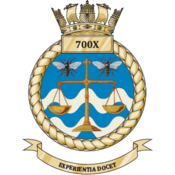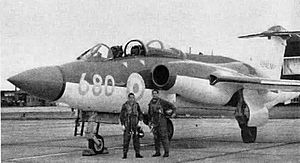700 Naval Air Squadron facts for kids
Quick facts for kids 700X Naval Air Squadron |
|
|---|---|

Squadron badge
|
|
| Active |
|
| Country | |
| Branch | |
| Type | Flying squadron |
| Role | Test and evaluation of Remotely Piloted Air Systems |
| Part of | Fleet Air Arm |
| Home station | RNAS Culdrose |
| Motto(s) | Experientia docet (Latin for 'Experiences teaches') |
| Aircraft |
|
| Commanders | |
| Current commander |
Lieutenant Commander M Howard |
700 Naval Air Squadron (700 NAS) is a special test squadron in the Royal Navy’s Fleet Air Arm. Their job is to try out new aircraft and technologies to make sure they work well for the Navy.
Contents
Squadron History and Missions
700 NAS started on January 21, 1940, in Orkney, Scotland. Its first role was to manage and support aircraft that launched from battleships and cruisers using catapults. These planes included the Supermarine Walrus flying boat, and the Fairey Seafox and Fairey Swordfish floatplanes.
During World War II, 700 Squadron aircraft were involved in important missions:
- In June 1940, a Walrus plane from the squadron spotted the German battleship Scharnhorst.
- In May 1941, a Walrus from HMS Norfolk was hit by enemy fire while tracking German ships before the Battle of the Denmark Strait.
- One of the squadron's Walrus planes, working with South African ships, sank an Italian submarine called Ondina in July 1942. This was the last time a Walrus successfully attacked an enemy submarine.
- Another Walrus from 700 NAS helped damage and capture a French submarine, Poncelet, in November 1940. The crew of the Walrus received bravery medals for their actions.
The squadron was temporarily closed in March 1944. However, it reopened later that year as a Test Pilot School.
Testing New Aircraft
In August 1955, 700 NAS was reformed to help introduce new aircraft types. From 1957, it was based at RNAS Lee-on-Solent and worked on bringing in the Westland Whirlwind HAS.7 helicopter.
Intensive Flying Trials Units
Over the years, many special units were created under the "700 NAS" name. These units were called Intensive Flying Trials Units (IFTUs). Their main job was to test new aircraft before they were used by the Navy. Each unit had a letter after its name, like "700X" or "700Y."
These units tested many different aircraft, including:
- The de Havilland Sea Vixen on aircraft carriers like HMS Victorious.
- The Saunders Roe P.531, which helped develop the Westland Wasp helicopter.
- The Fairey Gannet and Hawker Sea Hawk for landing and taking off from ships.
- Later, they tested helicopters like the Westland Wessex, Westland Sea King, and Westland Lynx.
- They also tested jet aircraft like the Blackburn Buccaneer, McDonnell Douglas F-4 Phantom II, and BAe Sea Harrier.
700 NAS was closed again in July 1961. But the IFTUs continued to operate independently, focusing on getting new aircraft ready for the Fleet Air Arm.
Modern Testing Roles
In December 1998, the squadron was brought back as 700M Squadron at RNAS Culdrose. Their main task was to test the AgustaWestland Merlin HM.1 helicopter. This unit closed in March 2008, and its work was taken over by another squadron.
The squadron reformed again in May 2009 as 700W NAS. This time, they focused on the Lynx Wildcat helicopter. They helped prepare the Wildcat for active service. In July 2014, 700W NAS merged with another squadron to form 825 Naval Air Squadron, which became the first unit to use the Wildcat operationally.
Today's Role: Unmanned Aircraft
Today, the squadron is known as 700X NAS. It works with Remotely Piloted Air Systems (RPAS), which are also known as drones. They test these drones and help prepare them for use by the Royal Navy.
700X NAS also supports other units that use the Insitu Scan Eagle drone on ships. In November 2019, the squadron began testing two new drones: the AeroVironment RQ-20 Puma and the AeroVironment Wasp III. By 2021, 12 Puma drone systems were being used by the squadron. This allows small teams to take these drones onto Royal Navy ships whenever needed.
Aircraft Tested by 700 NAS
Over its history, 700 NAS has been involved in testing many different types of aircraft, including:
- AgustaWestland Merlin
- Westland Lynx
- Supermarine Walrus
- Westland Whirlwind
- De Havilland Sea Vixen
- Fairey Gannet
- Hawker Sea Hawk
- Saunders-Roe P.531
- Westland Wasp
- Westland Sea King
- Boeing Insitu Scaneagle


